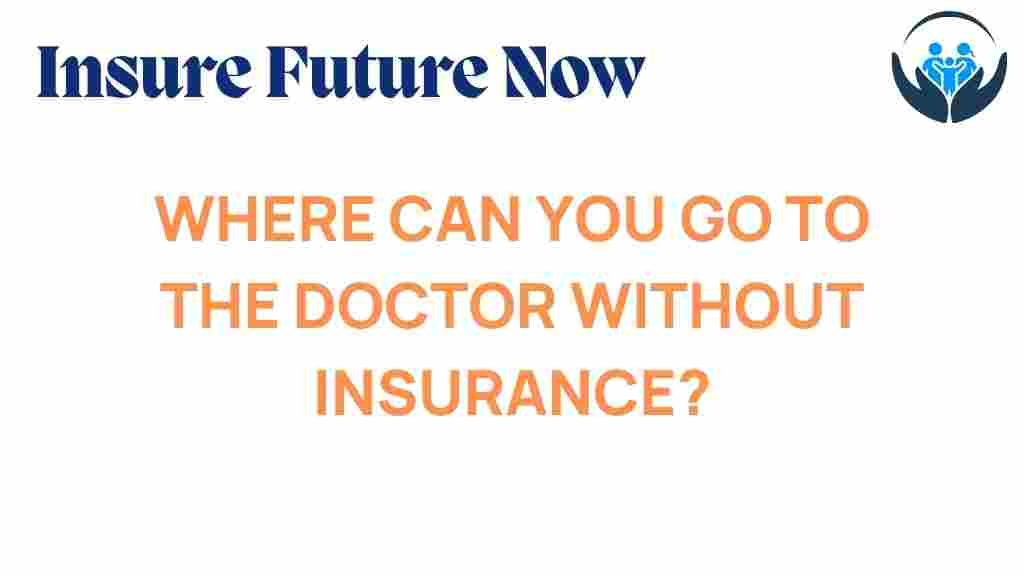Healthcare Access: Where Can You Go to the Doctor Without Insurance?
Finding medical services without health insurance can be a daunting task for many individuals. In the United States, millions of people face the reality of being uninsured, which often leads to delays in seeking care, increased health risks, and financial strain. However, there are several avenues available for uninsured patients to access necessary healthcare services. This article will guide you through the various options available, from community clinics to urgent care facilities, ensuring you know where to turn when you need medical assistance.
Understanding Healthcare Options for Uninsured Patients
When you are uninsured, it is essential to understand the healthcare access points available to you. Here’s a breakdown of the most common and effective options:
- Urgent Care Centers: These facilities provide immediate care for non-life-threatening conditions. They are often open late and on weekends, making them a convenient option for those without insurance.
- Community Clinics: These clinics offer comprehensive health services on a sliding scale, meaning they adjust fees based on your income. They can provide primary care, preventative services, and even specialty care.
- Free Clinics: Many areas have clinics that provide free healthcare services to uninsured patients. These clinics rely on donations and volunteers to operate.
- Emergency Services: In case of severe health issues, emergency rooms are legally required to treat all patients, regardless of their insurance status. However, be mindful of the potential high costs associated with this care.
- Health Resources and Nonprofits: Various nonprofit organizations and health resources can help you navigate the healthcare system and find low-cost or free services in your area.
Step-by-Step Process to Access Healthcare
Here’s a step-by-step guide on how to access healthcare services without insurance:
Step 1: Identify Your Health Needs
Before seeking care, assess your health needs. Are you dealing with a chronic condition, an urgent illness, or a routine check-up? Understanding your needs will help you choose the right type of medical service.
Step 2: Research Local Options
Use online resources to find community clinics and free clinics in your area. Websites like the Health Resources and Services Administration (HRSA) can help you locate nearby health centers.
Step 3: Check for Sliding Scale Fees
When contacting clinics, inquire about their payment policies. Many community clinics offer sliding scale fees based on your income, which can make care much more affordable.
Step 4: Gather Necessary Documentation
When visiting clinics, bring any relevant documents, such as identification, proof of income, or previous medical records. This information can help streamline your care.
Step 5: Visit the Clinic or Urgent Care
Once you’ve identified the right facility, visit them for your medical care. Be prepared for potential wait times, especially in community clinics that serve a high volume of patients.
Cost-Effective Options for Uninsured Patients
Here are some cost-effective options to consider when seeking healthcare services:
- Telemedicine: Many telemedicine services offer lower rates for consultations compared to in-person visits. This option can be especially beneficial for routine check-ups or minor health concerns.
- Pharmacy Clinics: Some pharmacies have walk-in clinics that offer basic healthcare services at lower prices than traditional medical facilities.
- Preventative Care: Focus on preventative care to avoid more severe health issues. This includes regular check-ups, vaccinations, and healthy lifestyle choices.
Troubleshooting Tips for Accessing Healthcare
If you encounter challenges while seeking medical services, consider these troubleshooting tips:
- Ask Questions: Don’t hesitate to ask clinic staff about costs, payment plans, and available services. They are there to help you navigate your options.
- Look for Community Resources: Local non-profits and health organizations often have resources for uninsured patients. They may also offer assistance in finding financial aid for medical bills.
- Negotiate Medical Bills: If you receive care and are later billed, you can often negotiate the amount owed, especially if you explain your uninsured status.
Conclusion: Taking Control of Your Healthcare Access
Navigating the healthcare landscape as an uninsured patient can be challenging, but it is entirely possible to find the medical services you need. By understanding your options, conducting thorough research, and advocating for yourself, you can access essential healthcare without insurance. Remember to utilize community clinics, urgent care facilities, and free clinics to maximize your healthcare access while minimizing costs. For additional resources and support, you can explore organizations that focus on helping uninsured patients find affordable healthcare solutions.
By being proactive and informed, you can take control of your health and well-being, proving that healthcare access is within reach for everyone, regardless of insurance status.
This article is in the category Coverage and created by InsureFutureNow Team
